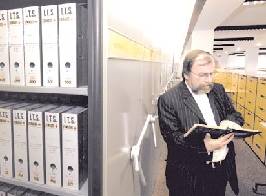It was created in 1943 and the Red Cross managed it.
The documents were elaborated by the Nazi burocracy. Eighteen millon victims are mentioned there. By the end of the year, investigators and historians will have access to them.
Records of dental treatments and medical experiments of concentration camps prisoners. The causes of the arrest and killing of the prisoners. Or the payment registers of the forced workers. All these documents written by the nazi burocracy will be soon available for the investigators.
Yesterday, the international committee managing the greatest file in the world about the victims of the nazism, decided to allow the historians to delve into the 50 millon documents kept in the tiny town of Bed Arolsen, on the west of Germany.
The so called ”Holocaust File” is unique as it gathers all the records of the prisoners, displaced people and victims of the Nazi persecution. All these documents were collected by the allies during and after the World War II. In this records there are details of the names, dates of birth and the causes of detention of 18 millon people who were victims of the Nazi killing machinery in Europe. On the shelves that if extended lenghtwise would measure 25 kilometers, there are all the details of the concentration and extermination camps, from the A of Auschwitz to the T of Treblinka.
It took ten years to take the decission of opening the files. Its official name is International Tracing Service. Managed by the International Red Cross, that appointed its own Director, this file is kept watched by eleven countries signatories to a treaty on 1955. Representatives from Germany, Belgium, France, Greece, Great Britain, Israel, Luxembourg, Italy, Holland, Poland and United States, last night agreed in Luxembourg to modify the text of the foundation chart of the archive. After this, it will be the turn of the Parliaments of the eleven countries to ratify the new text so that by the end of the year historians and researchers may have access to the documents.
Originally created by the allies in 1943 aiming at tracing people displaced during the Second World War, the file is funded by Germany. And although in the beginning it was meant to work only during five years, its mission, far from coming to an end, is still changing even nowadays. Last year it received more than 150 thousand tracing requests.
At first, the Arolsen International Tracing Service, was useful to trace relatives and loved ones ”lost” during the war. But after the fall of the Iron Curtain there was a flood of requests coming from the citizens of the former Soviet orbit countries who were eager to prove they had been in concentration camps or compelled to forced labors, in order to receive their pensions or an economic compensation.
An Ukranian, for instance, got his economic compensation as in Bad Arolsen there were lists of prisoners with lice in the concentration camp of Gross Rosen. In those lists, it was stated the he, Piotr, had had two lice on January 26, 1945. Although fewer and fewer, letters keep coming along with requests from immigration countries like Argentina.
So far, however, the information requested could only be provided to the involved people or their relatives. Any person who knows that anyone of his/her ancestors had been in a concentration camp and would like to have evidence by means of a document, he/she may write to Bad Arolsen to ask if his/her relative was registered in any paper of the nazi burocracy. The tracing is not always successful: in Bad Arolsen there are still 407 thousand cases unsolved.
Since 1996, investigators and historians have been able to work only on the 2 percent of the file that is not concerned on particular people. But from now on, they may have access to the rest of the documents piled up in shelves and card files that mention 18 millon victims of the Nazi regime. Among these papers there are, for example, the list of Gypsies deported to the extermination camp of Auschwitz and their ages, from babies to octogenarians. Furthermore, the list of the murdered people in Buchenwald, with the exact date, time, prisoner number and their personal effects can also be found.
During long years historians have been asking for access to this file which has an important historical value. Germany and Italy opposed to this request not so long ago. On April, however, the German Justice minister, Brigitte Zypries, promised in Washington D.C., that Germany would support the opening. The Museum of the Holocaust in Washington and Yad Vashem in Israel pressed them for opening the files. Both museums have copies of a great part of the Bad Arolsen documents referred to Jews, the vast majority of the victims of the Nazi regime.
Consultations
In order to send tracing people requests to the files in Germany, visit the site www.its-arolsen.org (site in English, French and German), or write to the e-mail itstrace@its-arolsen.org , or post a letter to International Tracing Service, Grosse Allee 5-9, 34444 Bad Arolsen, Alemania.
Translation: Graciela Forman

